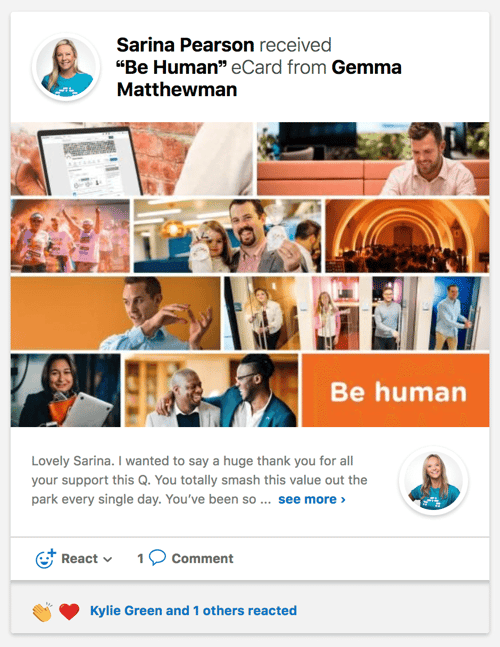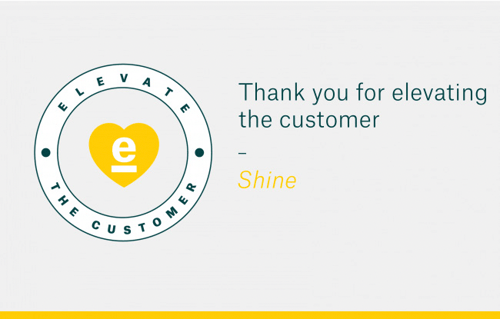We all know that recognition is a key component for a healthy work environment and is one of the ways to give people what they crave at work so they are more motivated, committed and engaged.
Seventy percent of workers say that motivation and morale would improve if managers simply said 'thank you' more.
And we know that a lack of recognition and motivation is one of the reasons why employees look for a new job. But what might not be as widely known and understood is that recognition can also be used as a strategic tool for encouraging your team to perform (and showing them how to perform) in ways that support your company values and drive tangible results for your business.
Take a moment and imagine this: Imagine if everyone in your organisation fully understood your company values, mission and/or purpose and worked to consistently deliver on them each day through their day-to-day actions and interactions.
Consider the impact it would have on:
| You: | "I'm more likely to get support when I need it." |
| Your customers: | "Our customers will get the same message and level of service no matter who they interact with." |
| Your company: | "We can save time and money for the company, when we do things right the first time." |
And the effect on your business can’t be ignored.
According to a study from Gallup, 77% of employees who understand what their company stands for and what makes it different from competitors also strongly agree that they’ll stay with the company for at least one year.
But it doesn’t have to exist solely in your imagination. You can inspire your team to work according to your values, mission and/or purpose by sharing why they are important, setting expectations for how they can do so and incorporating them into your recognition efforts. Here are a few ideas to get you started:
First, concentrate on sharing the why
Chances are, you already have established company values, a mission and/or purpose. Your core values serve as a guideline for who you are as a company, what you do and why it is meaningful.
They are the underlying mindset and attitude that people should have when coming to work each day.
And they can make a real difference in helping direct your team to achieve the results that are most important to your company. Here at Reward Gateway, we strive to connect our employees to our company values in everything we do – especially when it comes to employee recognition.
Our values-based, peer-to-peer eCards are shared on a social wall, visible to everyone in the organisation to view and react to with emojis, which helps us spread the message of what good looks like, connect our people to our values and create a ripple effect of recognition.

Sharing stories of individual and team success help teams better understand how they could live the company values, and also feel empowered on how to recognise their peers for behaviours, too.
So take a few minutes to revisit your values. Are they still representative of who you are as an organisation? Do your values speak to your team? Does your team understand what they mean and how they can deliver on them?
If not, it might be time to sit down and revamp your company values so employees can connect with the greater purpose and importance of what they do every day. And, when you do so, make sure to support your values with “the how.”

Next, use behaviours to set expectations for how to live your values
Make sure your team understands how they can and should bring your values to life. Define the actions that support your values through specific behaviours. Defining behaviours in support of your company’s more aspirational values, mission and purpose helps take them “off the wall” and make them real, achievable things your team can work toward.
One way to create your list of behaviours is to ask a group of employees (thought leaders and champions from different areas of your company) to share a few behaviours that represent them or another team member “on their best day.”
What is it that the person does that makes them a great person to work with? Or, what is it that the person does to delight customers?
This exercise should give you more than enough examples to craft the top 10 or 20 behaviours that support your values.
Once you have your top behaviours, share them with your team. Whether that means posting them on your company’s website, incorporating them into a culture book or internal messaging, clearly communicate your company values and make sure they’re visible and easily accessible for all employees.
The more your people can see and interact with your values, the more likely they are to embrace them and truly live them day in and day out. And what is the best way to do that? Consistently share examples of people demonstrating your values through your recognition program.

And finally, connect your people to your company values through recognition
Use recognition to invite your team to share stories about your values and the behaviours that support them in action. For the greatest impact, encourage your team to follow the steps that make recognition a little more strategic than just saying “thank you.”
| Three steps to make employee recognition more strategic |
| Step one: Tell the action |
| Step two: Connect to an area of focus or company value |
| Step Three: Explain the impact |
Your recognition program is an excellent tool for bringing different locations, departments, working groups, etc., together on one platform where they can learn from and celebrate each other’s successes.
Our clients use filtering/sorting on their social feeds to quickly drill down into the different groups and see where employees are living the values and behaviours, as well as uncover where the team might need a little more encouragement.
.jpg?width=500&name=Reward%20Gateway%20Event%20-42%20(1).jpg)
Employee recognition can be the propeller you need to encourage and celebrate your company values and connect your people.
One of our clients, Suncorp, united its workforce and reinforced its mission, purpose and values through a simple but powerful recognition and recognition program, called Shine, designed to keep the new vision, the “One Suncorp” business model and company values front of mind.
To continue improving employees' connection to the values through recognition, Suncorp launched values-based peer-to-peer eCards and quarterly award nominations. The eCards included values such as "Thank you for elevating the customer" and "Thank you for creating brilliant experiences," among others.

Employees use the Shine program daily to send a staggering 76,000 eCards every year, and receive an average of 200 nominations for company awards each month. The platform helps reinforce desirable behaviors, while linking everyday achievements to the organisation's purpose, mission and values.
Building your values and the behaviours that support them is the first step toward a strong culture. Reinforcing those values and behaviours through continuous, strategic recognition is the best way to ensure those values become embedded in everyone’s day-to-day actions and interactions.
The results will speak for themselves!
%20(1).jpeg) Alexandra Powell
Alexandra Powell

